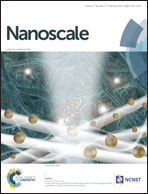Facile preparation of an immobilized surfactant-free palladium nanocatalyst for metal hydride trapping: a novel sensing platform for TXRF analysis†
Abstract
In this work, a simple route for the synthesis of surfactant-free immobilized palladium nanoparticles (Pd NPs) and their use as effective nanocatalysts for metal hydride decomposition is described. A mixture of ethanol : water was used as the reducing agent. Ethanol was added in a large excess to reduce the ionic Pd and stabilize the obtained Pd NPs. Ethanol is adsorbed on the surface of Pd allowing steric stabilization. Freshly prepared Pd NPs were immobilized onto quartz substrates modified with 3-mercaptopropyltrimethoxysilane. Pd interacts with the thiol group of the alkoxysilane that is adsorbed on the surface of NPs without the dissociation of the S–H bond. Different parameters affecting the synthesis of Pd NPs and their immobilization onto quartz substrates were evaluated. A comprehensive characterization of the synthesized Pd NPs was carried out by transmission electron microscopy (TEM), whereas total reflection X-ray fluorescence (TXRF) spectrometry was applied in order to evaluate their catalytic activity for solid–gas reactions. Immobilized Pd NPs were applied as nanocatalysts for the dissociative chemisorption of arsine at room temperature, yielding the formation of As–Pd bonds. Quartz substrates coated with nanosized Pd could be used as novel sensing platforms for total reflection X-ray fluorescence analysis. Arsenic can be detected in situ in natural water with a limit of detection of 0.08 μg L−1.


 Please wait while we load your content...
Please wait while we load your content...